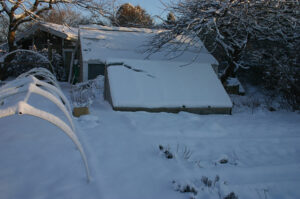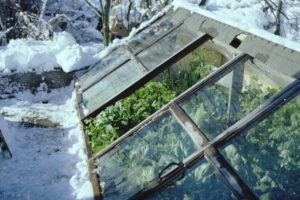It’s late August, and it’s hot, but my unheated greenhouse needs to be readied for winter vegetables. I’ve developed a method for getting this job done, one that not only adds nutrients to the soil but that also adds a natural heat source. Here’s what that method entails.
I start by digging out the greenhouse’s twenty-foot-long by four-foot-wide growing bed to a depth of about 1 to 1.5 feet (0.3 to 0.5m) The soil gets piled up outside the greenhouse and screened to remove any stones. This is New England, after all, where glacial stones persistently rise up toward the surface.

Next, I refill the bed, beginning with a couple pickup truck loads of fresh horse manure. Admittedly, shoveling manure into the greenhouse isn’t a fun job on a hot August day, but at least I can go for a swim in the ocean afterwards! The layer of manure is then topped with about a foot of screened loam mixed with compost. I now have my new bed. At this point, it’s about 15 to 20 inches (0.4 to 0.5m) above its normal level, but as the manure rots, the bed will slowly sink down.
Where did I come up with this approach? I read that manure was used to keep tropical trees and plants growing in London’s 1,851 feet (564m) long Crystal Palace in 1851 following the Great Exhibition there, which ended in mid-October. Some of these Crystal Palace plants were extremely tall, but the building’s interior height of 128 feet (39m) could easily accommodate them, including three mature elm trees. Everything was mulched with fresh horse manure scooped off the streets in this era before cars. Granted, using manure for mulch probably smelled pretty ripe, but even the tropicals continued to grow. The reason is the heat that the manure produces as it decomposes.

I first used this method in a cold frame, where I grew broccoli, cauliflower, lettuce, spinach, and some other greens right through the winter. When I then tried the method on a much larger scale in my otherwise unheated greenhouse, I found that it kept the soil quite warm essentially all winter long. The manure generated enough heat that the peppers lasted until Christmas and the tomatoes through much of January. I actually picked the last tomato on February 6th when outdoor temperatures are typically around 20°F (-6°C) and snow often covers my greenhouses. As an additional bonus, I lost pounds digging out the bed in the hot greenhouse!
By beginning this project in August, I have plenty of time to start my plants directly in the soil and get them well established in early fall. Then when winter’s chill arrives, I have this produce to harvest. If I want fresh herbs, greens, or vegetables for a winter salad or stew, I simply walk out to the greenhouse and pick them. What could be better than that?


